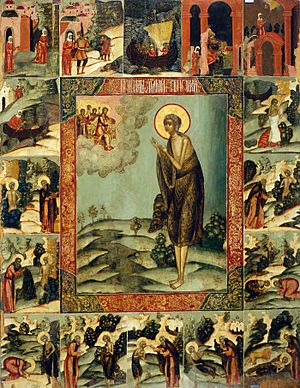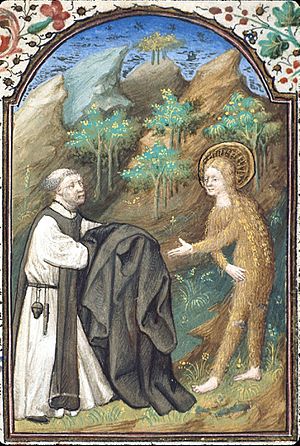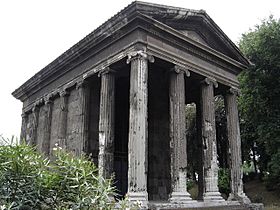Mary of Egypt facts for kids
Quick facts for kids SaintMary of Egypt |
|
|---|---|

18th-century Russian icon of Saint Mary of Egypt
|
|
| Virgin | |
| Born | c. 344 Province of Egypt |
| Died | c. 421 Trans-Jordan desert, Palaestina I |
| Venerated in |
|
| Canonized | Pre-congregation |
| Feast |
|
| Attributes | Cilice, skull, loaves of bread |
| Patronage | Chastity (warfare against the flesh; deliverance from carnal passions); demons (deliverance from); fever; skin diseases; temptations of the flesh |
Mary of Egypt (born around 344 AD, died around 421 AD) was an Egyptian saint. She is highly respected in the Eastern Orthodox and Coptic Churches as a "Desert Mother." The Catholic Church also honors her as a patron saint for people who are sorry for their past mistakes.
The Story of Mary's Life

Most of what we know about Saint Mary of Egypt comes from a book called the Vita. This book was written by Sophronius of Jerusalem, who was a leader of the church in Jerusalem from 634 to 638 AD.
Mary of Egypt, also known as Maria Aegyptiaca, was born in the Province of Egypt. When she was twelve years old, she ran away from her parents. She went to the big city of Alexandria. There, she lived a very wild and uncontrolled life for seventeen years.
A Change of Heart
After seventeen years, Mary traveled to Jerusalem. She went there for a big church celebration called the Exaltation of the Holy Cross. Her story says that when she tried to enter the Church of the Holy Sepulchre for the event, an invisible force stopped her.
Mary realized this was because of her past actions. She felt very sorry for how she had lived. Outside the church, she saw an icon (a religious painting) of the Theotokos (the Virgin Mary). Mary prayed to the Virgin Mary for forgiveness. She promised to change her life and become a very religious person.
Life in the Desert
After her prayer, Mary tried to enter the church again. This time, she was able to go in. She honored a relic (a holy object) of the True Cross. Then, she returned to the icon to say thank you. She heard a voice tell her, "If you cross the Jordan, you will find glorious rest."
Mary immediately went to a monastery near the River Jordan. There, she received forgiveness and Holy Communion. The next morning, she crossed the Jordan River to the east. She went into the desert to live alone as a hermit and pray for forgiveness. She only took three loaves of bread with her. After she ate them, she lived only on what she could find in the wild.
Meeting Zosimas
About a year before she died, Mary met a monk named Zosimas of Palestine in the desert. When he found her, she looked very different, almost not human. She asked Zosimas to give her his cloak to cover herself. Then, she told him her life story.
Mary asked Zosimas to meet her at the Jordan River on Holy Thursday the next year. She wanted him to bring her Holy Communion. When he did, she walked across the river on the water to reach him! After receiving Communion, she told him to meet her again in the desert the following Lent.
The next year, Zosimas went back to the same spot where he first met her. It was about twenty days' journey from his monastery. There, he found her lying dead. An inscription written in the sand next to her head said she had died the very night he gave her Communion. Her body, which had not decayed, was miraculously moved to that spot. Zosimas buried her body with the help of a passing lion. When he returned to his monastery, he told the other monks her life story. This story was passed down by word of mouth until Sophronius wrote it down.

When Mary Died
There are different ideas about the exact dates of Mary's life. Some experts even wonder if she was a real person. This is because her story is similar to other "desert mothers." It is hard to create a timeline for her life.
The dates given in the Catholic Encyclopedia say she was born around 344 AD and died around 421 AD. Other sources suggest she died in 530 AD. The only hint in her story is that she died on April 1st, which was a Holy Thursday. This means Easter that year would have been on April 4th.
How Mary is Remembered
In religious art, Mary of Egypt is shown as an old woman. She often looks very thin and tanned from the sun. Her hair is usually gray and messy, and it covers her body, or she wears the cloak Zosimas gave her. She is sometimes shown with the three loaves of bread she bought before going into the desert.
Feast Days and Celebrations
The Orthodox Church celebrates her feast day on April 1st each year. They also remember her on the fifth Sunday of Great Lent. On this day, priests often bless dried fruit after the church service. The story of Saint Mary, written by Sophronius, is read during a special prayer service on the Thursday before this Sunday.
The Catholic Church lists her feast day on April 1st in their calendar. Anglicans also honor her. In Italy, she became known as a patron saint for "fallen women," much like Mary Magdalene.
Churches Dedicated to Mary
Many churches and chapels are named after Saint Mary of Egypt. Some of them include:
- The Temple of Portunus in Rome, which was renamed Santa Maria Egiziaca, Rome in 872 AD.
- The Church of Santa Maria Egiziaca a Forcella, Naples.
- The Church of Santa Maria Egiziaca a Pizzofalcone, Naples.
- A chapel in the Church of the Holy Sepulchre in Jerusalem. This chapel marks the spot where she had her change of heart.
See also
- Desert Mothers
- Syncletica of Alexandria
- Sarah of the Desert
- Margaret of Cortona
- Paula of Rome
 In Spanish: María de Egipto para niños
In Spanish: María de Egipto para niños


